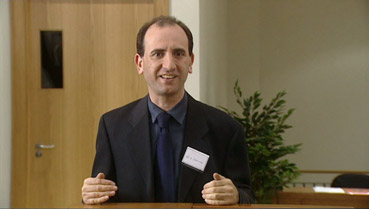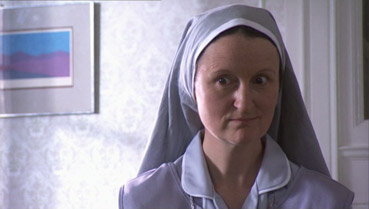|
If
the name Armando Iannucci is unfamiliar to you then fear
not, you're likely to be in good company. He's never been
on the front cover of Radio Times, you won't see
his face on advertising billboards, and he's never been dropped into the jungle and asked that they get him out of there.
But then for the most part Iannucci has been positioned
firmly behind the camera as a writer and producer on such
shows as The Day Today, Knowing
Me, Knowing You and I'm Alan Partridge.
Not a bad pedigree.
In
late August of 2001 a new Iannucci show appeared, one starring
not Chris Morris or Steve Coogan, but Iannucci himself,
and as himself. A bit of a risk, especially for a Channel
Four already corrupted by Big Brother and
the like, but the cult potential was there, and if enough
people saw it then word of mouth would...

Three
shows in, two planes were flown in to the World Trade Centre
in New York and the only thing the majority of TV viewers were watching
was the news and the plethora of
opportunistic documentary and current affairs programs that
sprang up in the incident's wake. Iannucci's show was seen by a few,
and they did talk about it, and later repeat screenings
expanded the audience further, but we're still talking a
very small following here, not enough to convince the television
types that a second season would be worth their while. Which
is something of a shame.
Iannucci's
approach might best be described as observational surrealism,
scattershot comments on small but significant aspects of
everyday life played out with the slightly fractured reality
of a just-before-you-wake dream. As well as featuring in
many of the sketches, Iannucci provides the sometimes tenuous
links as a slightly cynical, slightly paranoid everyman who
confides in his audience and shares his views on the world as it affects and worries him. Largely self-depreciating,
his insecurities will doubtless prompt some sympathetic
nods – his inability to function effectively in social
and business situations, his difficulty parking in vehicle-packed side roads, his failure to kick a ball in public
or dress for a jog without prompting howls of derision –
but it's when he connects these to an underlying conspiracy
theory that he really moves into interesting territory. His
failed attempts to hold sway with a crowd of football supporters
watching a match in a pub, for example, turn out not to
be down to his lack of sporting knowledge but because
the supporters are all being fed up-to-date information
through ear-pieces from experts located in the pub cellar. And that
guy who is always the life and soul of the party is shown
only able to be so because someone is hiding witty lines
of dialogue for him in his food.
Several
characters re-occur throughout the series, from the insufferable
television execs to the hilarious Hugh, an old man who
recalls his youth as a sort of alternate reality in which
elements of modern life seem to have slipped back through
a worm hole ("Of course the internet was in black and
white in those days and was only on for three hours a day
– we used to get dressed up in our Sunday best to log on
to it"). One of the funniest has to be the straightforwardly
named East End Thug (played by familiar face Alan Ford,
who played Bricktop Polford in Snatch),
who fixes a washing machine by barking threats at it and loudly
berates a woman in her own home for not reading every word
of the current issue of The Observer. But top prize has
to go to Iannucci's barber, whose slightly accented, often
nonsensical stream-of-consciousness ramblings repeatedly
reduced me to fits of giggles.*

Many
of the sketches are downright inspired. Personal favourites
include the quiet country village that hires an East European
sniper to spice up their lives by shooting at them, the
'Walking With Nazis' TV show parody, the man who accidentally
screws his hand to a wardrobe and is too embarrassed to
tell his wife, the impassioned plea by Kenyan villagers
to save British theatre, the couple who are shown around
a house that turns out to have been drawn by mischievous
children, the nun who runs a home for middle-aged men
(the lead performance alone sells this sketch), and the man
who follows the sound of his young daughter's imaginative
storytelling to discover that the fantasy creatures she is talking
about are all real – "Don't tell anyone about this!"
she sternly warns, then sends him away.
Iannucci's
past association with Chris Morris is frequently evident
in the structure and tone (there are occasional similarities
to Morris' pioneering Jam), and in his
cheerful skirting with the taste barrier – the priest
who sleeps with all of his parishioners, the young schoolgirls
whooping with delight at a male puppet doing a striptease,
the design consultants who help a woman fashion a really
effective suicide note, the Knife Attack reunion in which
the attackers joke and exchange funny stories with their
victims – just stopping short at the point where Morris would leap in with both feet.
But this is no criticism of Iannucci's approach, which is
different enough to that of the mighty Morris to give this show
its own very specific and instantly engaging identity. If
you've not caught it on its two TV runs – and most did not
– then I'd really recommend checking it out. It has all
the makings of a cult show (being cancelled after one season
certainly helps), but it's also smart, inventive, and often
very, very funny.
Framed
16:9 and anamorphically enhanced, the show was shot largely
on what looks like digibeta with a few DV inserts and looks
as good as most other UK shows shot in this format –
if you have any VCI discs of UK comedy series you'll have
an idea what to expect. Good detail, colour and contrast,
with deliberate variances on all three caused by filters
and post-production effects. On the whole, an unsurprisingly
pleasing transfer.
Sound is the standard Dolby 2.0 stereo and does the job
clearly and with some stereo separation, but there's nothing
flash going on here.
For
a show that only ran one season and few have actually seen, The Armando Iannucci Shows have received
decent treatment on DVD. There are some very nicely designed
menus and transitions, and the extra features here, though
not exactly numerous, are nonetheless all very worthwhile.

Most
surprising is that there is a commentary track
on all eight episodes, the first four featuring Armando
Iannucci, fellow producer Adam Tandy and fellow writers
Kevin Cecil and Andy Riley, the last two of whom are replaced
by producer Davis Schneider on the final four episodes. All
of these commentaries are furiously busy with stories, information
about the making of the show and specific scenes,
and the world in general, and there is even intermittent
information provided on the European Champions League final,
which was playing out at the time the commentary was recorded.
This is an absolute must for anyone who enjoyed the show,
as the banter is sometimes as comical as the series itself and occasionally as risky on matters of taste, not least in the rather jocular remarks about the
September 11th attacks (a date Iannucci insists be referred to under the British date system of 11/9) and
how they affected the show's first screening. Consistently
interesting and entertaining, there's never a dull moment
here, and once you hear one, like the show itself, you'll
either tune out or be in for the full eight.
There
are a six deleted/extended scenes:
Kangaroo (2:02) extends one of
the barber's ramblings; Great Adult
(3:50) is a fuller version of Iannucci's school class on
being an adult; Coma (1:14) is
a scene discussed in the commentary in which a tape of East
End Thug threatening horrible consequences is used to revive
a coma victim; Nut Allergy (3:09)
is a further sketch featuring the elderly upper-middle-class
couple at dinner; St. Francis
(0:57) has the barber suggesting a fight between Lennox
Lewis and St. Francis of Assisi; Traffic Lights
(1:34) features more material of the company man whose ideas
no-one takes seriously; and Porn Film
(6:03) looks behind the scenes on a porn film shoot in which
the star refuses to go naked and demands script revisions
to make the story more realistic.
Cast
& Crew lists just about everyone who had
anything to do with the show.
One
final thing I will mention is probably not included with
the DVD, but you never know. Just for the record I'm working
from a press copy of the series, a plain-looking disc in
a clear plastic case, with details of the production supplied
on an accompanying press release. Usually these are fairly
straightforward black-and-white A4 affairs, but just occasionally
you get one that can't help but put a smile on your face,
and the 4-page A4 colour piece here is just such a case.
Wittily written in Iannucci's own style (I could almost
believe it was written by him – maybe it was, but
full marks to whoever did if not), it provides an amusing
and everso slightly cynical introduction to the series.
Quietly mocking the misleading use of terms like 'special
edition' and 'collector's edition' on DVD covers, it reproduces
a favourable quote from celebrity gossip magazine Heat and then proceeds to wonder "in reality what can a
plumbing magazine know about an eight part comedy series
originally broadcast on Channel 4?" A similarly positive
line from The Observer prompts the question "What
can a publication about standing and watching life go by
really tell us?" I can only hope some of this made
it to the DVD cover. If it does, make sure you give it a
read.
An
unusual and imaginative oddity that fell victim to circumstances
that effectively killed the show after just once series.
You could argue, quite rightly, that it lacks the sheer
satirical bite of Chris Morris of the sink-through-the-floor
comedy-of-embarrassment that Steve Coogan nailed with Alan
Partridge, but part of the charm of The Armando
Iannucci Shows is their disarmingly gentle approach
and the everyday nature of their observations. The programme
is well served on Freemantle's DVD, and we can only hope
that its release finds the show a few more fans.
* A typical example: "Something people
don't realise about Emma Freud is that she's got a big spider
tattoo all over her head. And she's also got an antler growing
out of her head as well. Yeah, just the one. She used to
have two, but she lost the other one in a fight with Sade,
in the gutter, back in 1986. They was fighting over some
man or something like that, the usual sort of thing. Anyway
they locked horns, so to speak, and I think one of Emma
Freud's antlers got caught in Sade's jaws, because she's
got them, uh, detachable jaws, a bit like a snake, you know,
so she can swallow big objects whole, like, for example,
I don't know, like a little baby pony, or a football or
something like that. And that's what gives her a distinctive
singing voice."
|